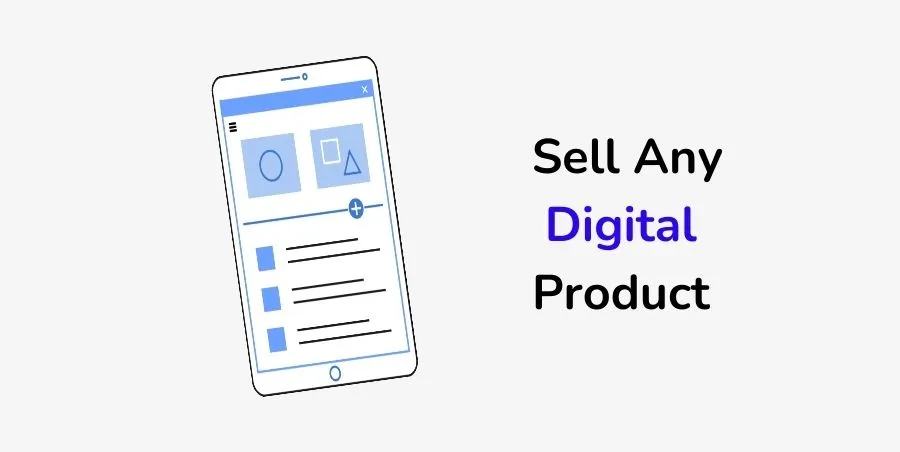Starting a blog is important, as research shows businesses with blogs get 55% more website traffic than don’t. You can start a blog for free, generate backlinks for your business, and increase the number of indexed pages, improving your performance on search results.
A blog helps you share content on diverse topics within your niche, thus attracting more readership. However, you may consider starting a youtube channel for even better results. But that’s not all. Here’re some of the reasons you should consider creating a business blog.
- Attract a larger audience
- Show or establish authority
- Boost your writing experience
- Creates endless opportunities
- Potential to make money
- Help you build relationships with other experts
Many people, especially beginners, constantly wonder how to start blogging or the tools and costs involved. And lucky for you, this article takes you through the entire process of starting a business blog and gives you success tips.
Disclosure: This content is reader-supported, which means if you click on some of our links, we may earn a commission, but the price on your end remains the same.
How to Start a Business Blog
Starting a business blog from scratch does not have to be a complicated process. You need to follow the steps and best practices discussed herein. And then start publishing your content. Specifically, follow these steps to get started the right way:
1. Find a Niche and Name your Blog
You have to be specific about what type of blog you want to create. Is it a blog about food, digital marketing, online business, or celebrity gossip? Or news or educational websites? While finding a niche, ensure it is appropriate to your business (potential online business) goals.
Find a niche our interested in and can make you money. Then, based on your niche, select a domain name. You’d want to ensure the domain you’re choosing is available, and it’s not more than 10 characters or two words. And confirm the availability of social media usernames.
You can use Namecheck.com for that purpose, and it’s free. Or use hosting websites like Dreamhost, Namecheap or Bluehost to check the availability of your preferred name. Then choose an available domain name, and proceed to the following stages.
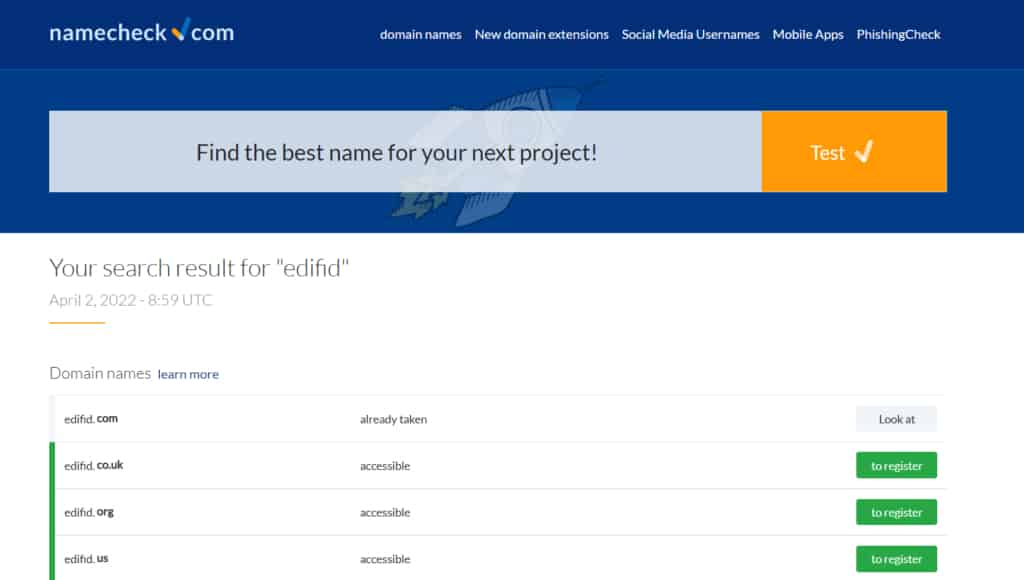
2. Buy Domain and Hosting
Now that you have a domain name (website name), you have to purchase it. Remember, you should renew your domain name annually.
Find a company that you’ll buy the domain from, as well as website hosting. One thing I love about Dreamhost is that you can get a free domain for the first year if you purchase a hosting package for 1 year or 3 years. The company sells a .com domain for $7.99/year.
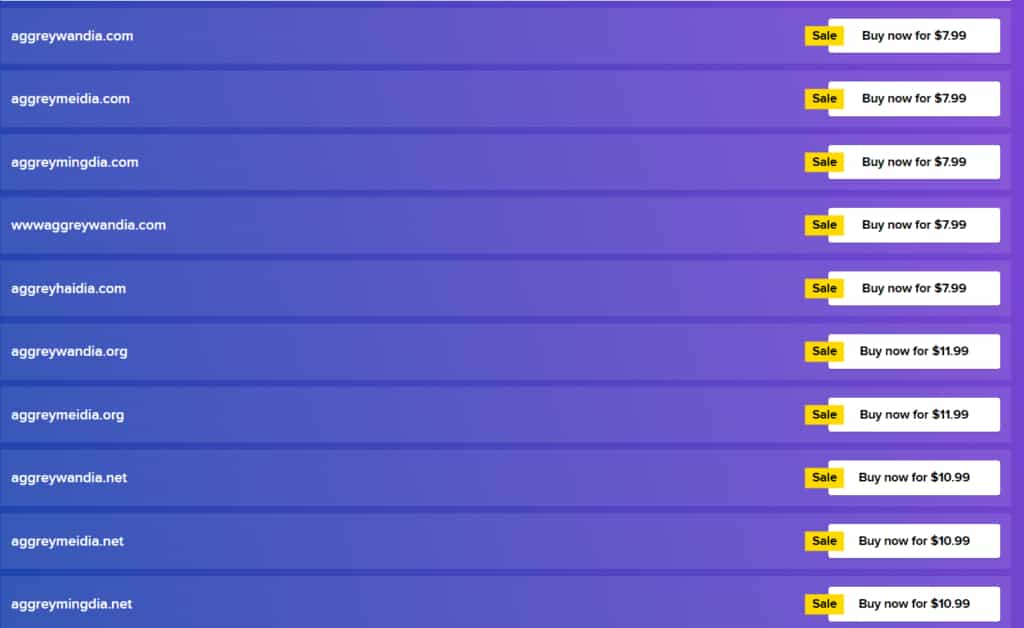
You can as well get an affordable hosting package from Dreamhost. Web Hosting is the process of renting or buying space to house a website on the World Wide Web. DreamHost charges a monthly fee of as little as $1.99 per month (a limited-time offer).

Or check out BlueHost as well, which charges hosting from $2.95/month. The good thing about these two companies is that you can install WordPress and create your website for free.
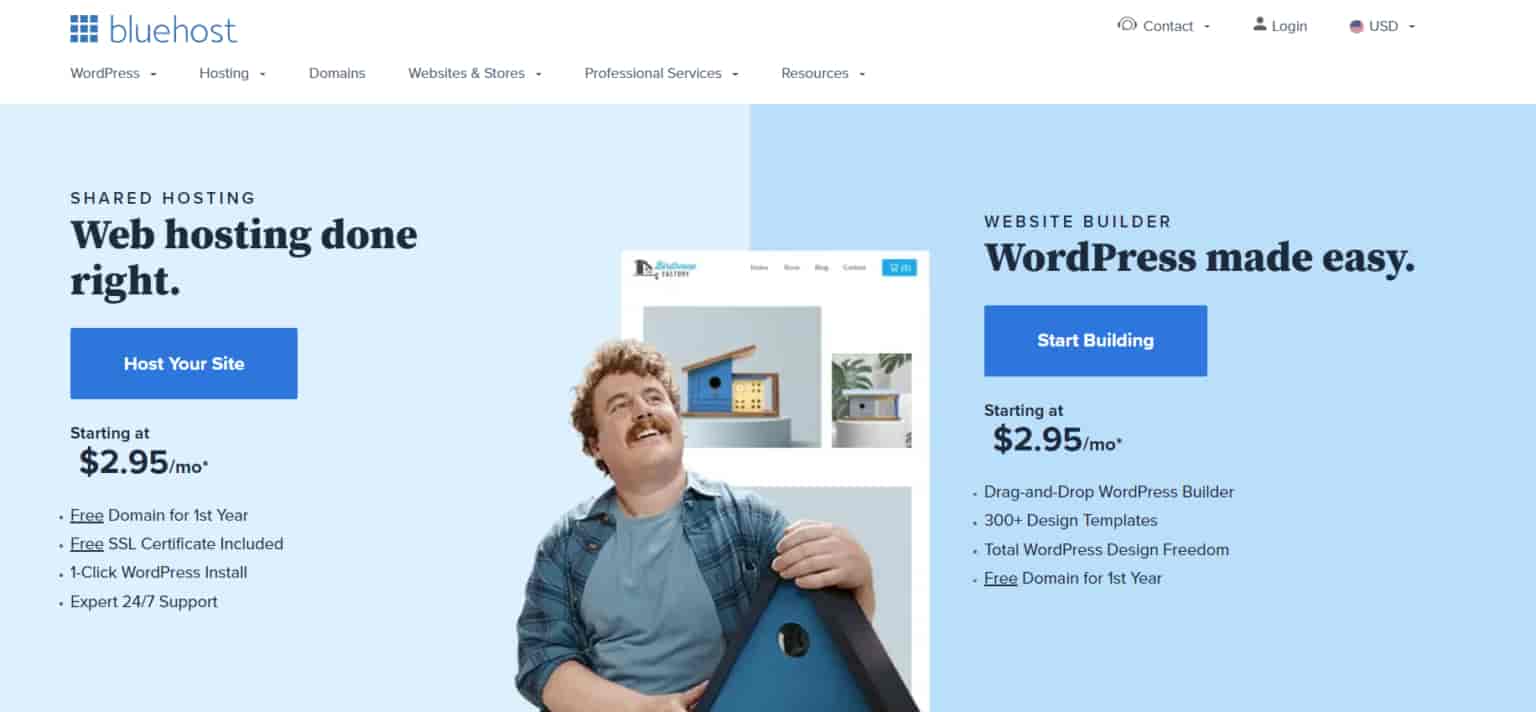
These companies are best for WordPress blogs. Here’s a compassion of the 10 best hosting companies, including their prices and whom they are best suited for. But if you’re on a tight budget, you can create a free blog on any of these free blogging platforms, including blogger.
Before you settle on any domain registrar or hosting website, check their reviews on Trustpilot or social media pages like FaceBook to understand what its users say. Or consult an expert or web developer in your region for more guidance on the most suitable package.
So, how much does buying and hosting a domain cost? Or how much does it cost to start a blog? If I settle with DreamHost, I’d need $7.99 for the domain name and $1.99/month ($23.88 per year) for a shared hosting package. That’s $31.87 (Ksh 3,500) in total.
However, the final cost depends on your domain extension (.com, ..net, .org, .co.ke), available offers, and your hosting package. And whether you intend to hire a developer.
3. Start Creating your Blog
You have options when it comes to building a blog or website. For instance, you can learn coding skills and create your site independently or hire a freelancer to do it for you. But you can avoid all that struggle and save money by installing a free blog with WordPress.
Do you know how many websites use WordPress today? As of 2021, over 455 million websites use WordPress builder, and the number continues to grow. Yet there are about 1.3 billion websites across the internet. So, over 30% of the sites use WordPress – that’s impressive.
The good thing is that most hosting packages have preinstalled WordPress, so all you have is to activate it and start to create or build your blog for free. But you’ll have to find a WordPress theme that interests you or meets your website’s requirements.
There are over 4,700 WordPress themes that you can choose from.
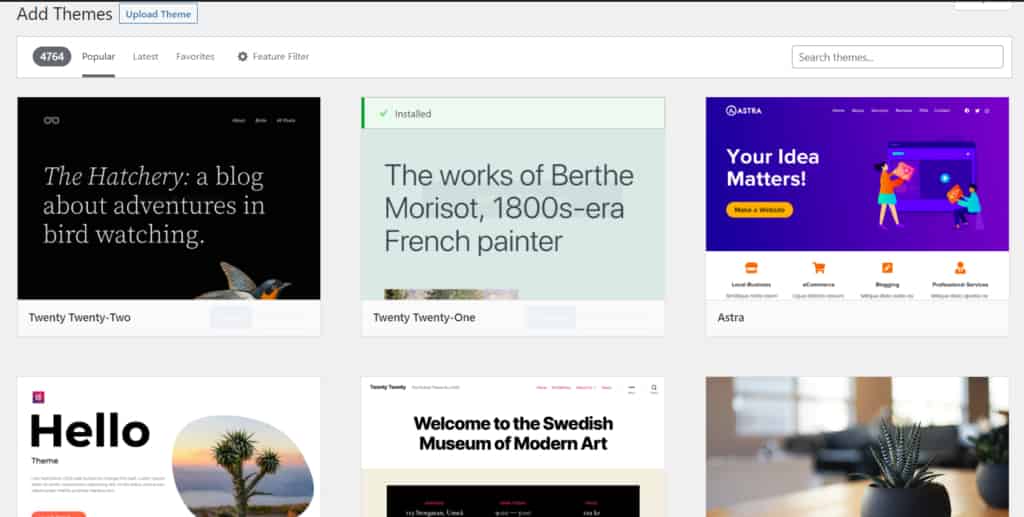
Alternatively, you can install Starter Templates and use builders like Elementor to create your website. You’ll have some templates to choose from, some of which are paid and others are free. Now, that depends on your budget. Although I suggest, you start with the free ones.
4. Write High-Quality Blog Posts
After customising your blog and dealing with the technical issues, you’re set to write your first blog. There’re best practices to follow while writing your articles. For instance, see how I wrote one on making money online in a conversational tone, short sentences, and paragraphs.
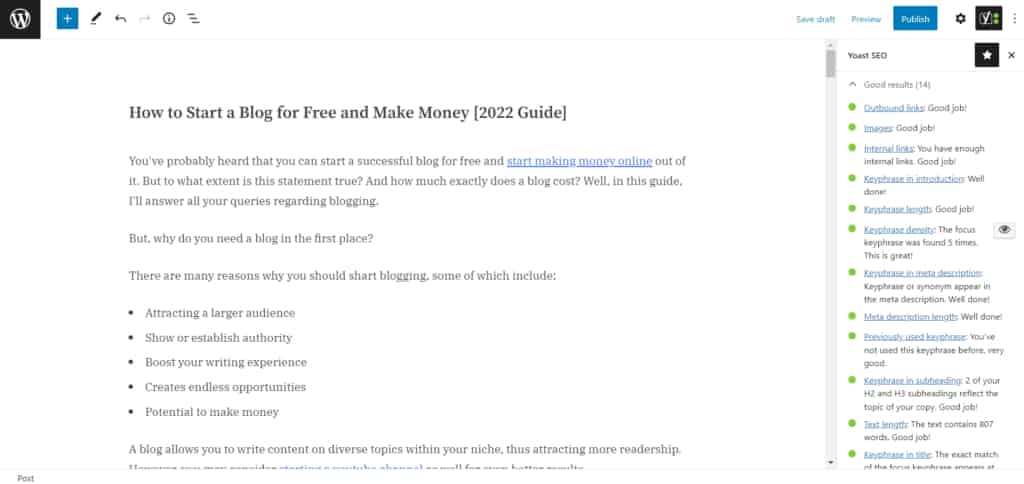
As seen above, Yoast SEO is very helpful while writing your website content or blog. It tells you whether you have used outbound links (linking to other websites), images, internal links, and key phrases in the introduction (first block or paragraph).
The plugin also shows you whether you have used the target keywords a few times and included them in title tags and meta descriptions.
Write in short paragraphs and include visual aids like videos and images. I prefer writing a maximum of 3 sentences per paragraph – to make my blog readable and organized.
If you’re new to writing, you can read other blogs to get ideas on how to write effectively. But don’t procrastinate, and focus on improving your skills over time. And divide your content into subtopics (H2, H3, H4…) to help your readers find information more appropriately.
5. Install Basic Plugins (WordPress)
Simply put, a WordPress plugin is software that “plugs into” your WordPress site. Plugins may add new functionality or extend existing functionality on your website. And some of the most common ones include:
- CAPTCHA 4WP – helps secure your site against scammers
- WPForms – form builder for email marketing
- Contact Form – enable visitors to contact you
- Email Subscribers – get email subscribers (key to email marketing) and send messages to them.
- All in One SEO – Best WordPress SEO Tool
- Icegram – create a campaign on your website – like email subscribers
- Site Kit by Google – set up Google Console, Analytics, and Adsense on your site
- Yoast SEO – helps with an SEO analysis and makes your content readable
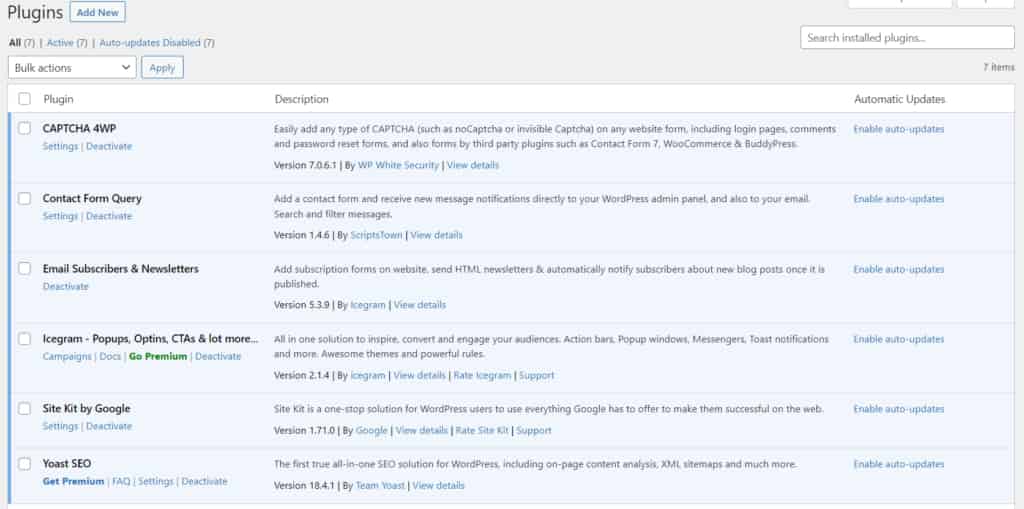
Plugins like Yoast SEO help conduct an on-page SEO audit of your article before publishing. That way, you can ensure the target keyword is placed strategically to help search engines understand your content. As a result, you end up bringing your website organic traffic.
6. Promote your Blogs Online
Starting a blog and writing a few articles for your business isn’t enough. You will rarely get traffic to your website if you do not promote your content online. You can adopt many digital marketing approaches – including email marketing, SEO, and video marketing.
Most importantly, you can adopt repurposed marketing strategy to promote your content online. For instance, if you have written an article on starting a business blog, you can create a social media post and share a link to your article. Or create a video on the same.
Don’t publish your articles and wait for traffic – you have to look for it. And when you have done so, earn how to monetise your content and generate more income for your business.
Conclusion
Now that you understand how to start a blog, create one. Remember, you need to decide what type of website you want to create and the target audience. I’d suggest you do so before settling on a domain name. And consider our long-term goals when deciding your niche and name.
For instance, if your website is on digital marketing, your target audience is majorly website owners or people seeking to start an online business. Be specific and focused from day one.
In summary, to start a business blog, I want you to:
- Find a niche and domain name
- Buy your domain and hosting
- Create your blog (website)
- Write high-quality blogs
- Install relevant WordPress plugins
- Promote your content online
- Keep learning and improving your content
Then learn these awesome blogging tips and start your content creation journey. Don’t procrastinate; start learning how to write great content and market it. With a little more time, you will become an expert in your industry and monetise your blog.
If you find the information resourceful, you can subscribe to our YouTube Channel and follow us on Facebook and Twitter for more updates and amazing content.
